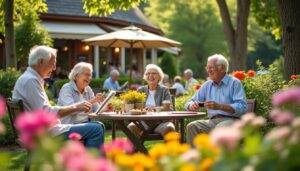Building age-friendly cities is a major challenge for our modern society. Greater Manchester serves as an inspiring example in this initiative. For nine years, a fruitful partnership has guided these initiatives.
Thanks to the collaboration between Ageing Better and the Greater Manchester Combined Authority, an inclusive ecosystem has emerged. This model addresses inequalities in key areas such as employment, housing, health, and transportation. The developed programs have had a significant impact on the daily lives of residents. By focusing on marginalized populations, these efforts enhance the opportunities associated with aging. The collective commitment has led to the creation of a truly age-friendly community. The lessons learned from this experience provide valuable insights for other regions. This initiative demonstrates that positive change is possible through a shared vision and coordinated actions.

In a world where the population is rapidly aging, creating an age-friendly urban area has become an essential priority. The collaboration between Ageing Better and the Greater Manchester Combined Authority (GMCA) offers an inspiring model for other regions looking to enhance the quality of life for seniors. After nine years of a fruitful partnership, the recently published report, Building an Age-friendly City Region: Learning from Greater Manchester, highlights the successes and lessons learned from this initiative.
Why is a collaborative approach crucial for developing an age-friendly region?
The establishment of an age-friendly urban area requires a long-term collaboration among various stakeholders. As Paul McGarry and Natalie Turner emphasized in their interview, a shared vision and common values are the pillars of such collaboration. This approach allows for pooling resources and defining ambitious yet achievable goals.
Since 2016, the strategic partnership between Ageing Better and the GMCA has demonstrated the importance of creating a strong ecosystem. By integrating diverse initiatives such as the Pension Top Up campaign or the Ageing in Place Pathfinder, the two organizations have addressed inequalities in key areas such as employment, housing, health, and transportation. This holistic approach ensures that the solutions implemented meet the diverse needs of seniors.
What have been the main achievements of this collaboration?
The achievements of this partnership are numerous and varied. One of the flagship initiatives was the Pension Top Up campaign, which significantly improved the pensions of low-income seniors. Furthermore, the Ageing in Place Pathfinder program facilitated the installation of seniors in suitable housing, thereby enhancing their autonomy and well-being.
Support for older workers has also been a priority, with dedicated programs encouraging seniors to remain active in the job market. This effort not only transformed the lives of the individuals involved but also enriched the practices and knowledge that other regions can draw inspiration from.
Moreover, initiatives related to fall prevention have been implemented, thereby reducing the risk of domestic accidents and improving the overall health of seniors. These actions are part of a comprehensive strategy aimed at making Manchester not only more accessible but also more inclusive for all its elderly residents.
What are the key ingredients for the success of a sustainable partnership?
According to Paul McGarry, one of the main lessons learned from this collaboration is the necessity of creating a compelling and realistic narrative around the pursued objectives. This narrative helps mobilize a core group of people who share the same values and aspirations, which is essential for maintaining the momentum of the project.
Natalie Turner, for her part, highlights the importance of a common goal and the celebration of successes. By acknowledging and sharing victories, even the smallest ones, the partners strengthen their commitment and motivation. This approach has transformed a small team of pioneers into a national network comprising nearly 100 age-friendly communities affiliated with the UK Network of Age-friendly Communities and the global network of the World Health Organization.
Another crucial aspect is the involvement of seniors themselves at every stage of the process. Their participation ensures that the initiatives truly address their needs and preferences, thereby enhancing the effectiveness and relevance of the programs put in place.
What challenges remain to be addressed for the continued development of an age-friendly urban area?
Despite significant advances, several challenges remain. One of the main ones is to raise awareness among the public and policymakers regarding the issues related to aging. Paul McGarry emphasizes the need to engage in a national conversation about aging, addressing the diverse and complex factors that influence the experience of aging in the United Kingdom.
Natalie Turner also points out the importance of maintaining efforts to prevent Manchester from becoming an isolated enclave of good practices. To achieve this, a national government focus is essential to create a fully age-friendly UK, where no one would be excluded from a fulfilling life due to their place of residence.
Furthermore, the fight against ageism remains a battle to be fought. This deeply ingrained form of discrimination limits the opportunities for seniors and reinforces negative stereotypes. It is crucial to continue promoting positive and inclusive attitudes towards elderly people, both in public policies and in society at large.
How can local initiatives inspire other regions to follow Manchester’s model?
The initiatives in Manchester offer a replicable model for other regions. For example, similar programs to the Pension Top Up campaign can be adapted to meet local specificities while drawing on the successes observed in Manchester. Additionally, the creation of a partner organization ecosystem can serve as a springboard for fruitful collaborations elsewhere.
The efforts of Manchester are also enriched by case studies and research applicable in other contexts. Resources such as Ageas’s acquisition of Saga illustrate how similar strategies can be implemented to attract seniors and secure economic growth. Similarly, initiatives from Hong Kong, detailed in Companies and social groups from Hong Kong, show how the senior economy can be energized through dedicated platforms.
What role does technology play in creating age-friendly regions?
Technology plays a crucial role in enhancing the quality of life for seniors. Innovative solutions, such as digital platforms for the senior economy, help better meet their specific needs. For example, initiatives like the initiatives in Hong Kong to boost the senior economy demonstrate how technology can facilitate access to employment, health services, and recreational activities for the elderly.
Moreover, technology can contribute to fall prevention through smart devices and health monitoring apps. These tools not only allow for monitoring the physical condition of seniors but also help prevent domestic accidents by quickly alerting emergency services when needed.
The digitization of public services and the creation of interactive platforms also promote the social inclusion of seniors, providing them with easy ways to stay connected with their community and actively participate in urban life.
How can public policies support the creation of age-friendly regions?
Public policies are essential to support initiatives aimed at making urban areas more age-friendly. It is crucial for local and national governments to recognize the importance of including seniors in all spheres of society. This includes funding dedicated programs, establishing favorable regulations, and promoting equal access to essential services.
Targeted policies focusing on improving appropriate housing, accessible public transportation, and health services are fundamental to addressing the needs of seniors. For instance, grants for renovating homes to make them more suitable, or public transport programs that are free or discounted for seniors, can greatly enhance their mobility and autonomy.
Moreover, policies aimed at raising awareness in society about ageism and promoting a positive image of seniors are crucial for creating a culture of inclusion and respect towards the elderly.
What benefits do seniors derive from an age-friendly urban area?
An age-friendly urban area provides numerous benefits both for individuals and for society as a whole. For seniors, this translates into better quality of life, greater autonomy, and enhanced social inclusion. Accessible housing, health services, and community engagement opportunities allow elderly people to remain active and connected.
Socially, an active senior population contributes to intergenerational diversity and the cultural richness of the region. Initiatives promoting senior employment, for example, leverage their experience and expertise while reducing loneliness and strengthening community ties.
Economically, seniors represent a significant and growing market. Strategies like those discussed in Ageas’s acquisition of Saga demonstrate how companies can attract seniors and secure their growth by meeting their specific needs. Additionally, initiatives like those in Hong Kong show that a well-managed senior economy can be a significant driver of economic growth.
How to assess the impact of initiatives aimed at making an urban area more age-friendly?
Assessing the impact of the initiatives implemented is crucial to ensure their effectiveness and to identify areas needing improvement. Indicators such as senior satisfaction, health and well-being improvements, and increased social and economic participation can serve as key measures.
The Manchester report includes detailed case studies and quantitative data demonstrating the positive effects of the programs on the senior population. For instance, the reduction of falls due to prevention programs or the increase in employment rates among seniors are tangible indicators of the success of the initiatives.
Furthermore, regular surveys of seniors can provide valuable feedback and allow for program adjustments according to the evolving needs of the community.
To go further, platforms for sharing best practices, such as those developed by international partners, allow for comparing strategies and adopting proven approaches to maximize the impact of local initiatives.
#>








